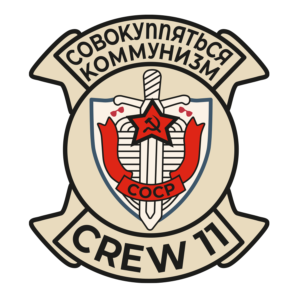International Brotherhood of Naval Flight Engineers
$5.00
Description
SHIPPING & SPECIAL DEALS
Comments
There are no comments yet.
CREW PATCH STORY
Flight Engineer
The Flight Engineer (FE) are responsible for flight safety. They operate engines and aircraft systems, and troubleshoot and correct malfunctions in flight. The military operates thousands of airplanes and helicopters. Pilots and air crew members rely upon trained personnel to keep aircraft ready to fly. Flight engineers inspect airplanes and helicopters before, during, and after flights to ensure safe and efficient operations. They also serve as crew members aboard military aircraft.
Inspect aircraft before and after flights
- Plan and monitor the loading of passengers, cargo, and fuel
- Assist pilots in engine start-up and shut-down
- Compute aircraft load weights and fuel distribution and consumption
- Monitor engine instruments and adjust controls following pilot orders
- Check fuel, pressure, electrical, and other aircraft systems during flight
- Inform pilot of aircraft problems and recommend corrective action
_______________________________________________________________________________________________________________________________
End of an era: Final P-3C flight engineer class graduates from VP-30 Lt. Matthew Guza VP-30 Public Affairs Oct 17 2018 “The Florida Times- Union
History was made Sept. 28 at Hangar 30 aboard Naval Air Station (NAS) Jacksonville. After more than half a century of a proud and longstanding tradition serving on the mighty P-3C Orion, the last ever class of student flight engineers (FE) graduated from Patrol Squadron (VP) 30. Commanding Officer Capt. Adam Kijek addressed the sizeable audience including families, friends and many current and retired FEs.
His remarks discussed how hard and special it is to become a Maritime Patrol and Reconnaissance Force (MPRF) aircrewmen, that MPRF aircraft are flying in every hot-spot in the world today, and that an aircrewman is part of the profession of arms and must always be ready should the nation call on them. He ended by discussing the historic nature of the day’s ceremony and how much the FE has been an indelible part of the fabric of the MPRF community. He then charged the graduates, “Be excited – for what is next, be professional – in all that you do, be humbled – to serve this great nation, and be ready – because you never know when history will find you.”
The FE is responsible for monitoring and operation of the aircraft’s complex systems. As aircraft of the past became larger and included more engines (accompanied by complex hydraulic, fuel, bleed air, electrical, ice protection and pressurization systems) the workload on two pilots became excessive, especially during critical phases of flight.
Propeller driven aircraft require a great deal of attention specifically due to the multitude of gauges and indicators; inattention to these could result in engine or propeller failure and quite possibly cause the loss of aircraft and crew if prompt corrective action is not taken.
The FE was born as a result of this problem, and these Sailors have served as an integrated member of the flight deck, working in close coordination with the two pilots during all phases of flight. FEs have ensured that the mighty Orion achieved operational success dating back to the Cuban Missile crisis, Vietnam War, and First Gulf War and continuing through Operations Enduring Freedom and Iraqi Freedom.
The FEs who graduate today are the last in a long lineage of aircrewman who have flown bravely while quickly diagnosing, rectifying and hopefully eliminating aircraft malfunctions which may potentially impact the safe execution of the Orion’s mission.
They are the last of a dying breed who began their work 82 years ago - the silent warriors of Maritime Patrol and Reconnaissance whose efforts and actions will never be forgotten by those who have the honor of saying that they have patrolled the world’s oceans in the last U. S. Navy propeller-driven patrol aircraft. The P-8A Poseidon, replacing the P-3C Orion, is a jet engine aircraft and does not require the role of an FE in the flight station.
With the highest attrition rate among all the training tracks at VP-30, the FE syllabus is arguably the most difficult at the “Pro’s Nest.” These last four students to successfully pass were presented with engineer hats signed by staff and former instructors.
There was also a class of P-8A acoustic operators and electronic warfare operators. The nineteen collective graduates will each proceed to their newly assigned fleet squadrons, in which they will receive further training before deploying across the globe. The three U.S. FEs have been assigned to the three remaining squadrons in NAS Whidbey Island, Washington, still operating the P-3C Orion.
AWVCM Andrew Jeter, senior enlisted leader of the Maritime Patrol and Reconnaissance Weapons School (MPRWS) and flight engineer by trade, still flies with VP-30 to instruct students learning the P-3C.
“Most Sailors think of the special operators, special boat units and the explosive ordnance disposal communities when they think of groups that possess a special bond, but the Aircrewman rating, especially the flight engineers, also maintain a tight brotherhood/sisterhood to take care of their own and expect only excellence in the execution of their duties,” Jeter said. “It is said that nothing of value is easily earned and becoming a flight engineer certainly falls into this category, because of the tough qualification track and the small number of Sailors who qualify to serve as `First Mech.’ A tightly knit group of friends has been formed, and these select few maintain a bond known as the International Brotherhood of Flight Engineers (IBNFE). IBNFE groups still meet to this day, maintaining the bond between retirees and active duty flight engineers and their families.”
Three honor graduates, one from each respective syllabus, were announced prior to closing ceremonies. These Sailors distinguished themselves from their shipmates with top marks throughout their course of study, which includes numerous tests, simulator events, and flights. AWO3 Michael Hormuth, AWO3 Conner Roth, and Senior Chief Marco Schnaeckel (German Navy) were presented with certificates as they received a hearty round of applause.
In closing, Capt. Kijek offered one last piece of food for thought to the new graduates. “Always remember what it means to be a professional. Amateurs work until they get it right, but professionals work until they cannot get it wrong.”



Comments
There are no comments yet.






Be the first to tell your patch story!